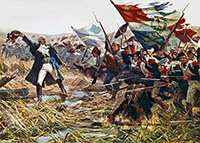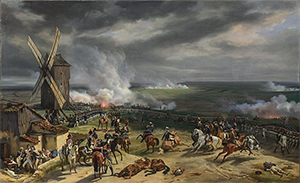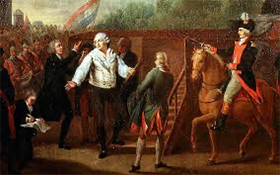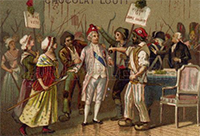The French King Louis XVI
Part 6: War and Execution
On August 10, things got out of hand entirely and a group of protesters stormed the Tuileries, seizing the king and the royal family and placing them in lockdown in the Square du Temple. Meanwhile, the Legislative Assembly called for a new National Convention, which met for the first time on Sept. 21, 1792. In the meantime, France was at war with Austria. On Aug. 17, 1791, Prussian King Frederick William II had issued the Declaration of Pillnitz, which asked other monarchs of Europe to help restore the French king to his absolutist throne. This served to heighten tensions within the French government. In fact, many people in France wanted to take their republican movement outside French borders. A significant number of people in the Low Countries (what is now Belgium and the Netherlands) appealed to France to help them achieve the same sort of revolution within their borders. One significant change to military procedures as a result of the drive toward more equality–that officers be appointed according to ability rather than nobility–convinced many existing officers to join those leaving the country. Thus, when France declared war on Austria on April 20, 1792, it did so with a relatively new raft of officers. The same was true for the equivalent of the enlisted men. Many of the 164,000 soldiers who went to war with Austria were poorly trained and poorly equipped. They had talented, experienced commander in the Marquis de Lafayette and Jean-Baptiste Donatien de Vimeur, comte de Rochambeau, both of whom had seen combat during the American Revolutionary War. But the egalitarian nature of the Revolution led many soldiers to question even these seasoned commanders. As well, the French Army faced enemies from within. Queen Marie Antoinette was from Austria. She sought to prevent a complete elimination of the monarchy by embracing the efforts of Austria and others in restoring her husband to her former power; to do so, she obtained her army's war plans and passed them to the Austrian war department. 
One bright spot for French troops was their new battle hymn, Chant de guerre pour l'armée de Rhin ("War Song for the Rhine Army"), which Rouget de Lisle had recently. composed. Soldiers across the country sang it, but it became known as the song of a battalion from Marseille and so became La Marseilliaise (by which it is still known today). The war was not kind to France from the outset. One group of French soldiers fled the battlefield and fell on their own general instead, accusing him of treason and executing him on the spot. Other French forces went into battle but found defeat. Rochambeau resigned, and Lafayette did not survive a subsequent reorganization. A second French invasion, in June, had some success, capturing two towns. The result, however, was the growth of the force allied against them. 
The Duke of Brunswick issued the Brunswick Manifesto, which proclaimed that any harm inflicted on the French royal family would result in devastation of Paris. He then marched at the head of an allied force of Austrians, French émigrés, Hessians, and Prussians, into the heart of France, besieging Verdun and then marching on Paris. What looked like certain French defeat turned into something entirely different at Valmy (right), on Sept. 20, 1792. French artillery ruled the day, and the allied force retreated. The beleaguered allied force, far from home, retreated further, battling against dysentery and broken supply lines as well as an inspired force of French pursuers. French troops seized the Prussian city of Mainz in short order and, at the end of October, Frankfurt as well. Back in Paris, the National Convention had been overrun by republican fervor, such that many were blaming the king for the early defeats and absolving him of any credit for the recent victories. More ominously, the Convention called the king to trial, on Dec. 11, 1792. He had been arrested after the August storming of the Tuileries and kept in the Temple. When the government abolished the monarchy, he became known as Citoyen Louis Capet. The main charge was treason, stemming from his attempt to flee the country in June 1791. The Convention also charged the king with attempting to ally with France's enemies in order to engineer an overthrow of the government and reinstate himself as the supreme head of the state. The discovery of an iron chest containing compromising correspondence validated this charge. 
Many republicans in the Convention wanted the end of the monarchy in any form and many who wanted the king dead. Foremost among these was Maximilien Robespierre, who declared that, "Louis must die so the nation may live." After a series of spirited debates, the Convention voted to convict the king. That vote was unanimous. The debate then turned to how to punish the king. That ended in a vote as well, and many deputies voted against execution. However, a majority did, and so the king indeed was put to death, on Jan. 21, 1793. He was 38. Among his last words were these: "I die innocent of all the crimes laid to my charge; I Pardon those who have occasioned my death; and I pray to God that the blood you are going to shed may never be visited on France." |
|
Social Studies for Kids
copyright 2002–2025
David White



 In June 1792, tempers boiled over again, as an armed crowd marched into the Tuileries and demanded that the king abrogate his veto power. A small number of protesters stormed into the king's quarters; one of the protesters had an axe and moved toward the king. Louis XVI calmed the aggressors by listening to their demands and promising to consider them. He sealed his promise by donning a red liberty cap that was the symbol of republicanism. A similar scene played out in another room, when another crowd surrounded the queen and her children and one of the crowd placed a red hat on the head of the crown prince.
In June 1792, tempers boiled over again, as an armed crowd marched into the Tuileries and demanded that the king abrogate his veto power. A small number of protesters stormed into the king's quarters; one of the protesters had an axe and moved toward the king. Louis XVI calmed the aggressors by listening to their demands and promising to consider them. He sealed his promise by donning a red liberty cap that was the symbol of republicanism. A similar scene played out in another room, when another crowd surrounded the queen and her children and one of the crowd placed a red hat on the head of the crown prince.
